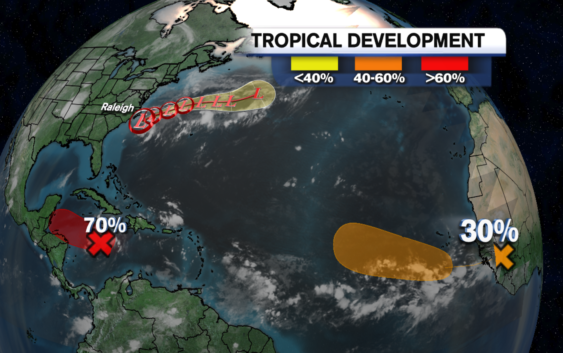- WATCH: Video Shows Confirmed Tornado touches down in Columbus County
- Residents begin clean up after storms, apparent tornado roll through NC Tuesday
- Flooding lingers in Liberty County neighborhoods near Trinity River with more rainfall expected
- North Carolina behind on hurricane preparedness, study shows
- North Carolina way behind on hurricane preparedness, study shows
Tropical Storm Nana forms in Caribbean Sea

Nana is moving west at 18 miles per hour and has strengthened with 50 mph winds.
People in Jamaica, Honduras, Belize, Guatemala and the Yucatan peninsula could see heavy rain from Nana. A Tropical Storm Watch was issued for northern Honduras and the offshore Roatan islands.
Tropical Depression 15 continues to move away from the United States and is not expected to strengthen into a tropical depression, according to the National Hurricane Center.
The system was located approximately 100 miles southeast of Cape Hatteras on Tuesday morning.
As of the 8 a.m. update, it is moving northeast at 13 mph. The system has maximum sustained winds of 35 mph. Tropical Depression 15 is expected to zoom away from the coast and out to sea throughout the week. It’s starting to encounter some stronger wind shear, preventing it from gaining strength and will track far enough away from land to not produce any direct impacts.
The next storm that strengthens into a named tropical cyclone would be named Nana and could be the earliest N-named storm ever, which is becoming the norm this season.
The 2020 hurricane season is shaping up to be one of the most active on record. So far this season, Cristobal, Edouard, Fay, Gonzalo, Hanna, Isaias, Josephine, Kyle, Laura, and Marco all set records for being the earliest of their respective letters to ever form.
That means this season is on pace to break the record for most named storms ever. The previous record for most named storms happened in 2005 when 27 named storms formed, including 14 hurricanes.
Plus, the historical peak of hurricane season has not even arrived yet. That occurs Sept. 15.
Storm Ready 2020: Preparing in a Pandemic
Next potential storm
Preparing your hurricane kit during COVID-19
Another system is expected to move off the coast of Africa this week. Some development is possible and it passes to the south of the Cabo Verde Islands. The system currently has a 40% chance to develop.
Copyright © 2020 WTVD-TV. All Rights Reserved.